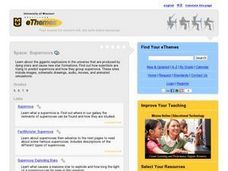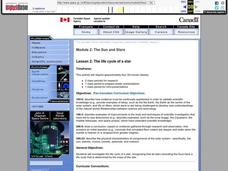Curated OER
X-ray Spectroscopy and the Chemistry of Supernova Remnants
This link takes you to a comprehensive unit that delves into emission spectra and supernovas. There are four parts: How and where elements are created, electromagnetic radiation, spectroscopy, and the newest technology for studying our...
Curated OER
Supernova Chemistry
Using spectroscopes, high school astronomy, physics, or chemistry learners observe emission spectra from several different sources. This stellar NASA-produced lesson plan provides terrific teacher's notes and a student handout. Make sure...
Las Cumbres Observatory
Plotting a Supernova Light curve
Supernovas burn for a short time but can give scientists extensive information about the universe. Learners analyze given data about the change in the light magnitude of a supernova. They look for patterns in the data and use them to...
Curated OER
Chandra Studies and Expanding Supernova Shell
In this supernova activity, students read about the expanding supernova shell that was discovered by the Chandra X-ray Observatory. Students solve two problems including finding the scale of the given images and determining the average...
NASA
Supernova Chemistry
By measuring the wavelength, frequency, and intensity of electromagnetic radiation, scientists determine the temperature, density, and composition of far away items. Scholars rotate through ten lab stations using a spectroscope at each...
Curated OER
The Big Bang
Fifth graders relate the elements in the human body to those produced during a supernova. For this space science and chemistry lesson, 5th graders listen to a lecture and view visuals about the big bang. They relate the production of...
Curated OER
2011 Nobel Prize Winners Announced
This assignment has young scientists read four different news articles about the 2011 Nobel Prize winners. Six questions are posed for children to write the answers. It is a relevant activity for getting middle schoolers to meet the...
Las Cumbres Observatory
Measure the Age of Ancient Cosmic Explosions
Supernova explosions mark the end of a star's life. Guide the class through an investigation that uses data to calculate the age of a supernova remnant. Using provided data and online software, they analyze data to determine the radius...
Las Cumbres Observatory
Measuring the Age of the Universe
Just when is the universe's birthdate? Pupils use previously collected spectra data to find the redshift and radial velocity of supernovas. They then calculate the distance before finally creating a Hubble diagram. Finally, individuals...
Curated OER
Star Facts
Throughout the elementary grades students explore the galaxy. This simple presentation listing the types of stars could be used as a quick review of the information students have learned. It could be augmented with additional information.
NASA
Measuring Dark Energy
You're only 10 minutes late? Do you know how much the universe has expanded in those 10 minutes? Scholars graph supernovae based on their redshift and see if the results verify Hubble's Law. If it does confirm it, the universe is...
Curated OER
Lifecycle of a Star
In this space science worksheet, students complete each statement with the correct word or phrase that related to the life-cycle of a star. Then they list the correct order of a stars life cycle. Students also define supernova and pulsar.
American Museum of Natural History
Cosmic Wallpapers
Decorate your screen with a cosmic wallpaper featuring the Orion Nebula, Helix Nebula, or Supernova.
Curated OER
Measuring Speed in the Universe
In this measuring speed in the universe worksheet, students use photographs of 3 astronomical phenomena including supernova explosions, coronal mass ejections and solar flare shock waves to find how fast they move. The photographs show...
Curated OER
Details from an Exploding Star
In this nebula worksheet, students read about the Crab Nebula and calculate the average speed of the expanding gas. They determine the size of the smallest clumps of gas and they draw the diameter of the solar system to scale.
Curated OER
Space: Supernova
Learners explore the gigantic explosions in the universe that are produced by dying stars and cause new star formations.
Curated OER
The Life Cycle of a Star
Young scholars investigate the life cycle of a star through research. Once research is complete, students prepare posters and present findings to class. Flash animation is included to help young scholars visualize life cycle of star...
Curated OER
The Life Cycle of a Star
In this stars worksheet, students read about the different stages in the life cycle of a star. Then students complete 3 short answer questions.
Curated OER
Black Holes Word Search
In this black holes word search, students locate terms relating to a black hole. A list of ten words is provided. An answer sheet is available.
Curated OER
Earth And Beyond
For this earth and space worksheet, students identify and locate vocabulary terms and names related to earth and space sciences. There are 53 words located in the puzzle.
American Museum of Natural History
Journey to the Stars
Fifteen detailed pictures and informative captions delve deep into the exploration of stars—their life cycle and importance in the universe.
Curated OER
Stars and Slopes
Pupils use the slopes of various curves plotted on log-log graph paper to classify stellar objects as binary stars, supernovae, or active galaxies.The data used in this lesson plan were obtained from X-ray astronomy satellites.
Starry Night Education
The Stars
Three astronomy activities in one resource! Here you will find one hands-on activity, one demonstration, both with discussion questions, and one activity worksheet. During these lessons young scientists discuss how stars are different,...
It's About Time
Our Community's Place Among the Stars
But isn't the Milky Way a candy bar? Lead a detailed discussion on the complex topic of our solar system and the Milky Way Galaxy as the class explores stellar evolution, structure, and investigates the relationship between luminosity...
Other popular searches
- Star Life Cycle Supernova
- Supernova Remnants
- The Supernova
- Supernova Explosions
- Supernova and Stars
- Supernova Activities
- Supernova Geometry
- The Supernova Geometry

























